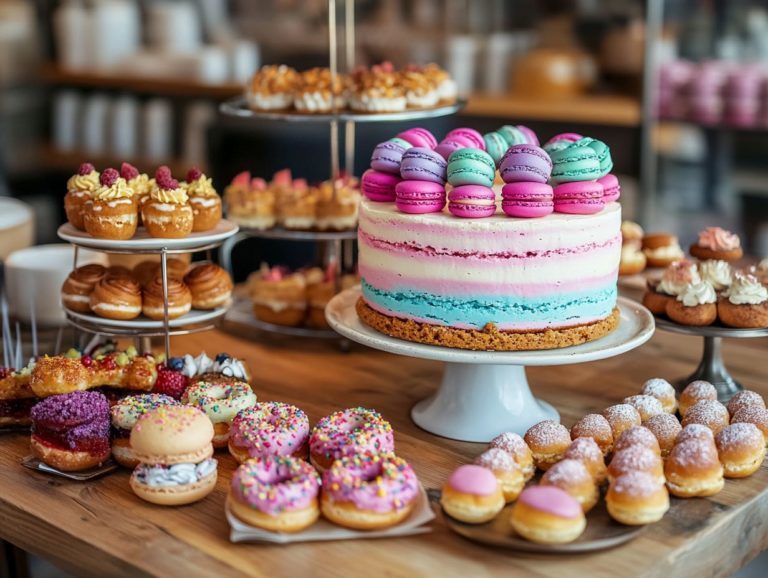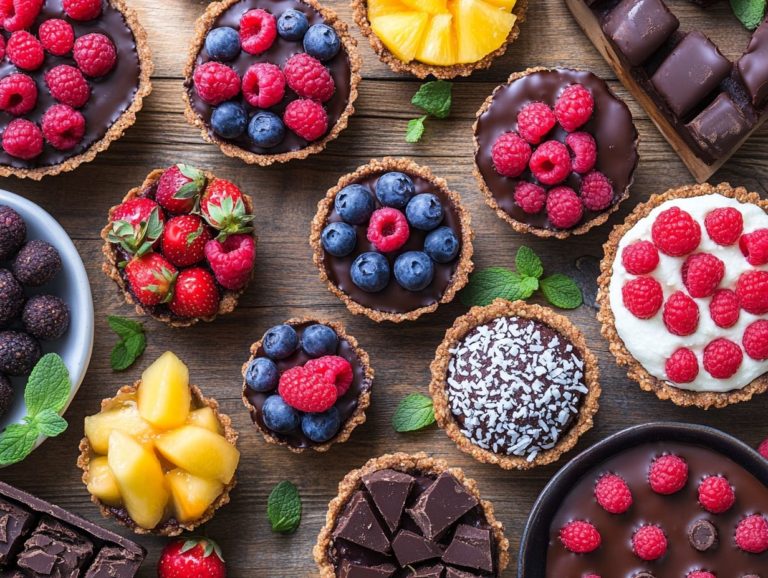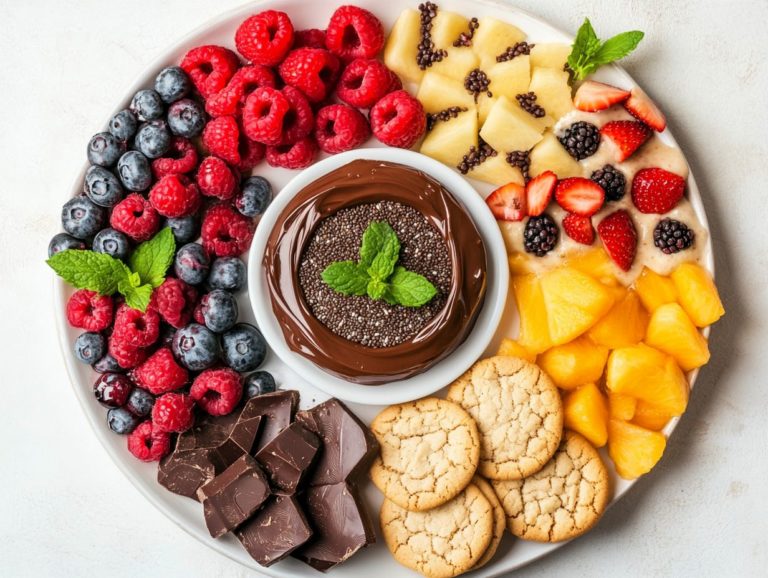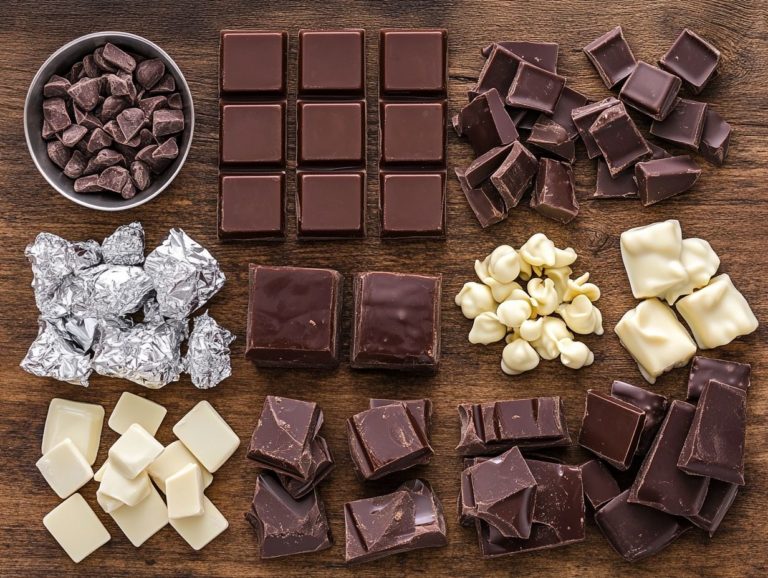How to Incorporate Textures in Desserts?
Desserts are not merely sweet indulgence; they are a harmonious blend of flavors, textures, and food properties that craft an unforgettable experience.
This exploration delves into the captivating realm of dessert textures, examining their texture characteristics and significance. It also offers practical tips for seamlessly incorporating them into your desserts.
Textures can elevate your desserts, enrich the dining experience, tantalize your taste buds, and enhance your overall food enjoyment.
Get ready to discover the exciting secrets of dessert textures that will elevate your baking game!
Contents
- Key Takeaways:
- What Are Textures in Desserts?
- Why Are Textures Important in Desserts?
- How Can You Incorporate Textures in Desserts?
- Combining Different Textures
- What Are Some Examples of Desserts with Textures?
- 2. Crispy Cookies
- 3. Creamy Cheesecakes
- 4. Chewy Brownies
- What Are Some Tips for Incorporating Textures in Desserts?
- 1. Balance the Textures
- 2. Experiment with Combinations
- 3. Consider Temperature
- 4. Think Outside the Box
- Frequently Asked Questions
- What does incorporating textures in desserts mean?
- How can I add crunchy textures to my desserts?
- What are some soft textures that work well in desserts?
- How can I use fruits to add texture to my desserts?
- Can different cooking techniques help create textures in desserts?
- Are there any tips for balancing textures in desserts?
Key Takeaways:
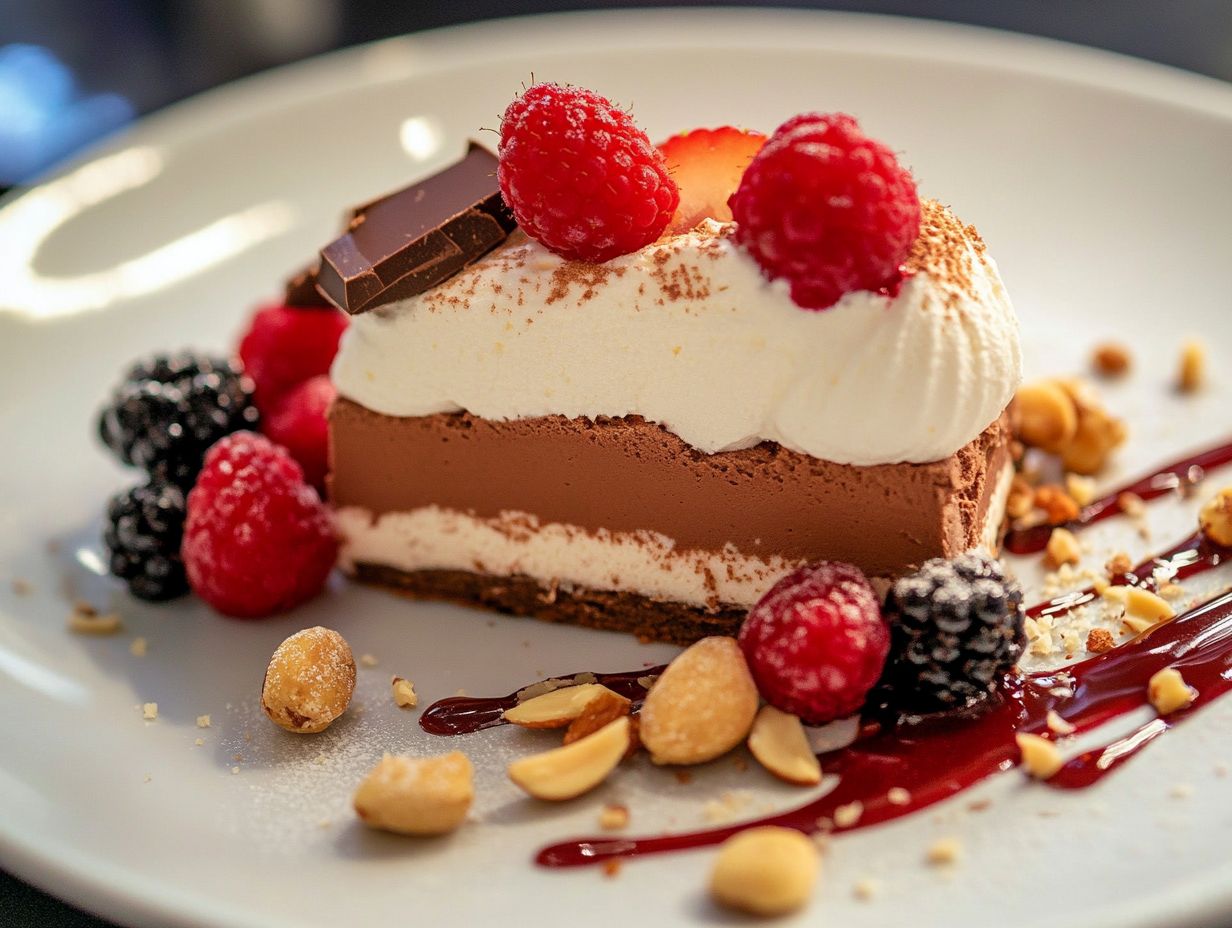
- Adding various textures in desserts can enhance the dining experience, food enjoyment, and make it more interesting.
- Experimenting with different ingredients, cooking techniques, and toppings is key to incorporating textures in desserts.
- Balancing textures and considering temperature can create a harmonious blend in desserts, making them more enjoyable and satisfying. This also helps in better texture perception and flavor perception.
What Are Textures in Desserts?
Textures in desserts encompass the myriad physical qualities that enhance your sensory experience while indulging in sweet treats. They are essential in elevating your enjoyment of food.
The texture of a dessert can vary dramatically, from the velvety smoothness and smooth mouthfeel of a creamy panna cotta to the satisfying crunch of crispy elements that beautifully complement the dish.
For chefs like Chef Edmund, grasping the intricacies of food textures is crucial in their quest to craft exquisite culinary experiences. They utilize fresh ingredients and innovative texture techniques to delight your palate.
What Are the Different Types of Textures?
Desserts offer an enticing array of textures that can transform your entire sensory experience, ranging from creamy and smooth to crispy and crunchy.
Consider the allure of creamy delights like strawberry panna cotta or Greek yogurt panna cotta; these dishes showcase innovative layering textures and unique elements like a delicate touch of melon garnish that truly stand out on the plate.
These textures not only elevate the visual appeal but also engage your palate, inviting you to explore the delightful contrasts at play.
Take, for example, the classic chocolate lava cake, which surprises you with a rich, molten center nestled within its soft outer layer a delightful revelation with every forkful.
Chewy textures found in treats like oatmeal raisin cookies or mochi ice cream provide a satisfying resistance that beckons you to indulge further.
Crunchy elements, such as the caramelized topping on cr me br l e or the crushed pistachios adorning a delicate pastry, infuse a delightful snap that enhances the entirety of the dessert experience.
By thoughtfully combining these textures, chefs craft a harmonious balance that captivates your senses and leaves an indelible impression.
Why Are Textures Important in Desserts?
Textures are essential in desserts, as they significantly impact your enjoyment and flavor perception with every bite. By engaging your senses, textures elevate your culinary experience.
Inviting you to savor the lightness of whipped cream or the delightful crunch of crispy toppings and garnishes like fruit tuiles, these elements come together in complex dessert creations that showcase fresh ingredients.
By ensuring each experience is both memorable and indulgent, texture analysis a method of assessing the feel and consistency of food can be employed to fine-tune these creations.
In conclusion, textures play a crucial role in desserts, enhancing flavors and providing a multi-sensory experience. Don’t hesitate to experiment with different textures in your own sweet dishes!
How Do Textures Affect the Overall Dining Experience?
The impact of textures on your overall dining experience is nothing short of profound, shaping how you perceive and savor your food and influencing both flavor and satisfaction. Imagine indulging in a perfectly crafted strawberry panna cotta with a silky mouthfeel, enhanced by the crunch of a fruit tuile such a combination can elevate your sensory experience and create a moment that lingers in your memory. The use of texture perception and sensory evaluation methods further enhances this experience.
Textures are crucial in how you engage with flavors; they can either enhance or contrast, ultimately determining whether a dish leaves you delighted or wanting. Take, for instance, the creamy richness of a classic chocolate mousse, which can be exquisitely complemented by the crispness of a caramel shard. Each bite becomes a delightful blend of indulgence and satisfaction, showcasing various texture properties.
Similarly, consider a layer of sponge cake interspersed with vibrant berry compote. This delightful interplay of softness and tartness invites you to explore both mouthfeel and taste. Recognizing this relationship underlines the significance of texture, not just in desserts but also in crafting a holistic dining experience that resonates with every guest, aligning with seasonal flavors.
Benefits of Texture in Desserts
Incorporating various textures in desserts offers a multitude of benefits, enhancing not only the food properties but also the flavor profiles and the overall dining experience. By employing texture modification techniques and exploring diverse cooking methods, you can introduce crispy elements or smooth layers that delight the palate while adding to the dish’s aesthetic appeal. Instrumental texture analysis can be particularly useful for achieving the desired textural attributes.
Imagine the captivating contrast of creamy mousses paired with crunchy toppings it’s a combination that captures attention and excites the senses. Incorporating dairy notes and edible flowers can further enhance this experience. You can experiment with techniques like sous-vide (a cooking technique where food is vacuum-sealed and cooked slowly in a water bath) to create delicate custards or use freezing and caramelizing to achieve delightful contrasts.
Incorporating airy meringues alongside rich chocolate ganache not only elevates the visual allure of your dessert but also enriches the flavor experience, transforming each bite into a harmonious blend of sensations.
A thoughtful combination of textures can truly transform a simple dessert into a true masterpiece, delighting both the eye and the palate.
How Can You Incorporate Textures in Desserts?
Incorporating food textures in desserts involves recognizing texture characteristics and utilizing sensory evaluation to guide your culinary decisions.
Incorporating textures into your desserts opens up a world of culinary possibilities, allowing you to craft truly memorable and satisfying experiences. By utilizing fresh ingredients or embracing innovative texture techniques, you can transform your desserts into a symphony of sensations.
Imagine the creamy layers of panna cotta complemented by delightful crispy toppings like crushed freeze-dried ingredients, or the delightful contrasts found in frozen desserts. Each element adds depth and intrigue, elevating your desserts to new heights. Incorporating dessert sauces like sugar syrup adds a layer of complexity.
Now is the perfect time to experiment with textures in your desserts! Try out these ideas and create delightful culinary experiences that will impress your guests.
1. Using Different Ingredients
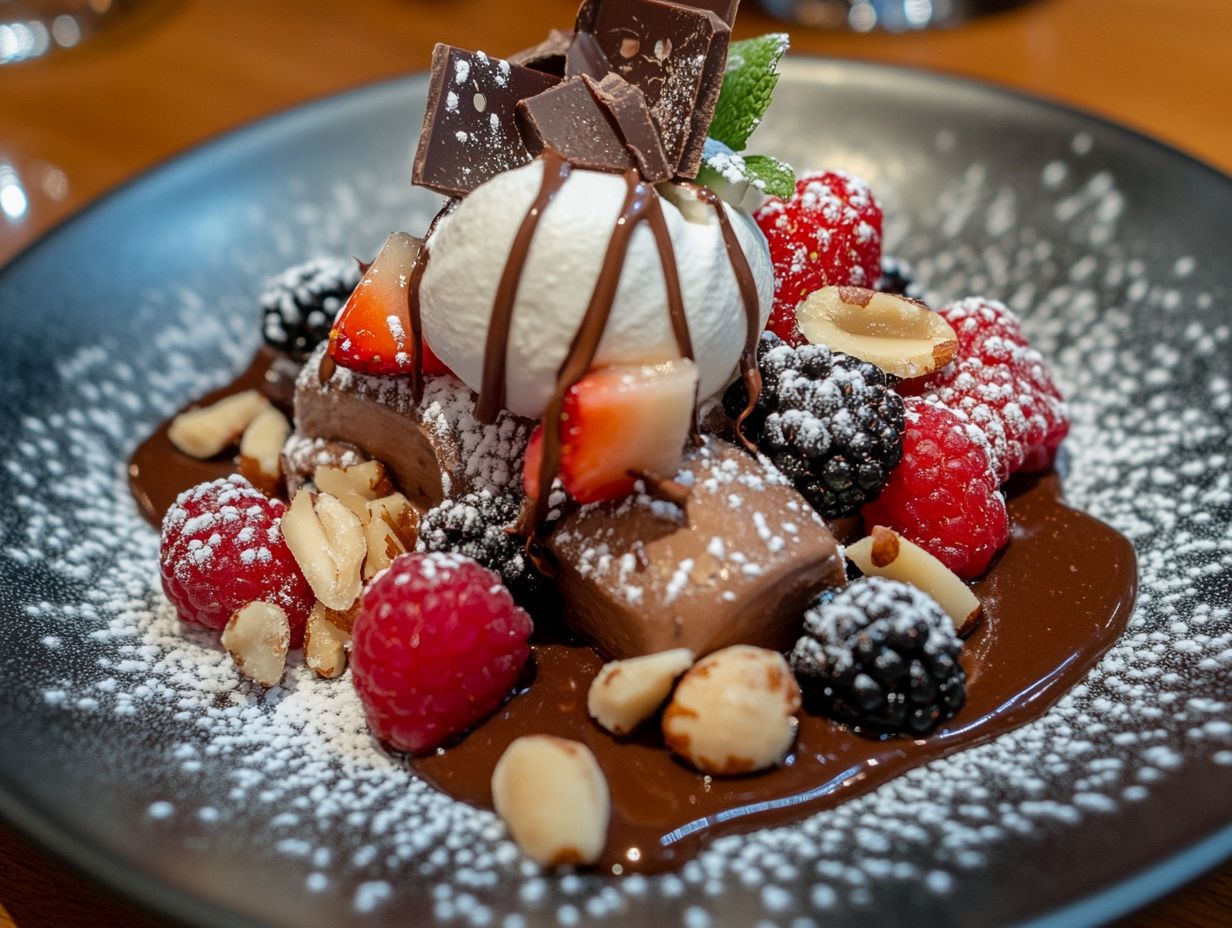
Utilizing a variety of ingredients is an essential strategy for you to create diverse textures in your desserts.
Each ingredient brings its unique texture properties that enhance the overall dish.
For instance, when you incorporate creamy elements like Greek yogurt alongside a fresh fruit preparation, you re crafting a delightful contrast that elevates both the flavor compounds and the entire sensory experience. Freshly sourced ingredients, such as those from Purely Artisan Foods in San Diego, can further enhance this experience.
Picture this: the crunch of crunchy nuts or granola pairs perfectly with a smooth chocolate mousse; this introduces an exciting interplay of textures that keeps your palate engaged.
Chewy components, such as dried fruits or caramelized pieces, add depth to your dessert, providing a satisfying bite that beautifully complements the richness of buttery pastries. Unique elements like Manuka honey or basil seeds can also enhance these combinations.
This harmonious balance of creamy, crunchy, and chewy elements fosters a layered experience, inviting you to savor each mouthful and appreciate the thoughtful craftsmanship behind your creations.
Emulsifiers and stabilizers can aid in achieving the desired texture.
2. Varying Cooking Techniques
Varying your cooking techniques is essential for developing distinct textures in desserts, as each method can dramatically alter the final product’s mouthfeel.
Techniques such as baking, freezing, and utilizing emulsifiers and stabilizers can introduce innovative textures, from crispy garnishes crafted from freeze-dried ingredients to a luxuriously smooth panna cotta. For instance, Sicoly from Monts du Lyonnais in Rhone Valley offers ingredients that can enhance these textures.
Consider this: baking yields a rich, golden crust on a tart, while steaming results in a soft and moist cake that simply melts in your mouth.
Meanwhile, the art of spherification (a technique that forms liquid into small beads) creates delightful bursts of flavor, exemplified in modernist desserts like fruit caviar. Adding edible flowers like dianthus can further enhance the visual and sensory appeal.
Churning ice cream incorporates air into the mixture, leading to a creamy texture that beautifully contrasts with crunchy toppings.
Each technique presents unique opportunities for exploration. Try these techniques today, and transform your desserts into unforgettable experiences!
Ultimately, these methods enable you to craft a diverse array of sensations that elevate the overall dessert experience and food enjoyment.
3. Adding Crunchy Toppings
Adding crunchy toppings is a simple yet effective way for you to enhance your desserts, introducing delightful crispy elements that contrast beautifully with creamy bases.
Take, for instance, a luscious strawberry panna cotta elevate it with crispy garnishes like a fruit tuile or a sprinkle of crushed freeze-dried ingredients. This creates an engaging dessert presentation that captivates the senses and highlights the dessert’s texture properties.
Beyond tuiles, consider crushed biscotti or candied nuts to provide a wonderful textural contrast when sprinkled over a velvety chocolate mousse.
Similarly, a scoop of ice cream can transform into an indulgent masterpiece when paired with caramelized popcorn or chocolate-covered pretzels. Both options are visually striking, pleasantly crispy, and enhance the overall mouthfeel.
Don t overlook the artful addition of toasted coconut shavings, which can impart a tropical flair to a coconut cream pie, balancing its rich flavor with a satisfying crunch.
These thoughtful toppings not only enhance the overall presentation but also elevate the food experience, inviting you to savor every bite with a delightful mix of textures that dances on the palate.
Consider adding crispy elements like fruit tuile or dianthus flowers for an even more unique and visually appealing dessert.
Combining Different Textures
Combining different textures is a powerful technique that enables you to create well-rounded desserts. It offers a satisfying journey for the palate and enhances flavor perception with each bite.
By skillfully layering textures like a rich, creamy dessert paired with a crunchy topping you can craft unique elements that delight diners and elevate their culinary experiences. This technique allows for a delightful interplay of texture properties and taste testing.
For instance, imagine a silky chocolate mousse accompanied by a crisp praline; that delightful contrast stimulates the senses. Similarly, a fluffy cheesecake adorned with a layer of crunchy cookie crumbs presents a captivating play on textures. When a velvety panna cotta meets a tangy fruit coulis, you ll experience the refreshing interplay of creaminess and acidity that keeps you coming back for more.
Each texture not only adds to the visual appeal but also enhances the overall taste experience, proving that thoughtful texture combinations are essential for memorable desserts.
What Are Some Examples of Desserts with Textures?
Imagine a world of desserts that masterfully highlight the art of texture. Each one delivers a distinct sensory experience that underscores the significance of food textures. Picture creamy indulgences like Greek yogurt panna cotta, which glides smoothly across your palate. This is contrasted by crispy cookies that provide a satisfying crunch with every bite.
Every bite of these desserts reveals a new story waiting to be uncovered! Each dessert you encounter tells a story through its harmonious blend of textures, transforming them into unforgettable creations that any culinary enthusiast would treasure.
1. Layered Parfaits
Layered parfaits serve as a splendid example of a dessert that elevates multiple textures. They artfully blend creamy layers with crisp granola or vibrant fresh fruit. These visually stunning creations not only captivate the eye but also provide a delightful contrast of textures that enhances your overall sensory experience.
The secret to achieving that perfect balance lies in your careful selection of fresh ingredients that cater to both taste and mouthfeel. Incorporating Greek yogurt or whipped cream introduces a luscious, velvety quality, while crunchy nuts or seeds deliver an exciting textural surprise. Seasonal fruits contribute to this multi-dimensional experience, infusing brightness and freshness into the mix.
When you embark on designing your own parfaits, think about layering your ingredients thoughtfully to create depth and intrigue. Consider alternating between sweet and tangy flavors, or adding unexpected elements like chocolate shavings or coconut flakes to elevate the dish further. Keep in mind that the key is in the contrast; by combining the smooth with the crunchy, you ensure that every bite becomes a delightful exploration of flavors and textures.
2. Crispy Cookies
Crispy cookies show how important texture is in desserts, providing a delightful crunch that beautifully contrasts with any creamy or rich elements you might encounter. Enjoy them on their own or paired with dessert sauces; the textural qualities of crispy cookies significantly enhance your flavor perception and overall enjoyment.
These cookies come in many forms, from classic buttery shortbread to nutty biscotti or indulgent chocolate chip variations. Each one contributes its unique crispness to the world of desserts. For instance, imagine the luxurious combination of chocolate-dipped crispy cookies, which elevate your dessert experience. Or think about the refreshing zing of pairing them with a tangy berry coulis to cleanse your palate. Adding spices like cinnamon or a touch of sea salt can also enhance traditional flavors, turning your dessert into an engaging experience.
You ll be amazed at how these crunchy delights pair perfectly with velvety ice cream or a luscious drizzle of caramel, transforming every bite into a delightful adventure that captivates the senses. For an even more sophisticated touch, consider incorporating savory dishes or emulsifiers ingredients that help blend oil and water, making your desserts smoother to create unique culinary experiences.
3. Creamy Cheesecakes
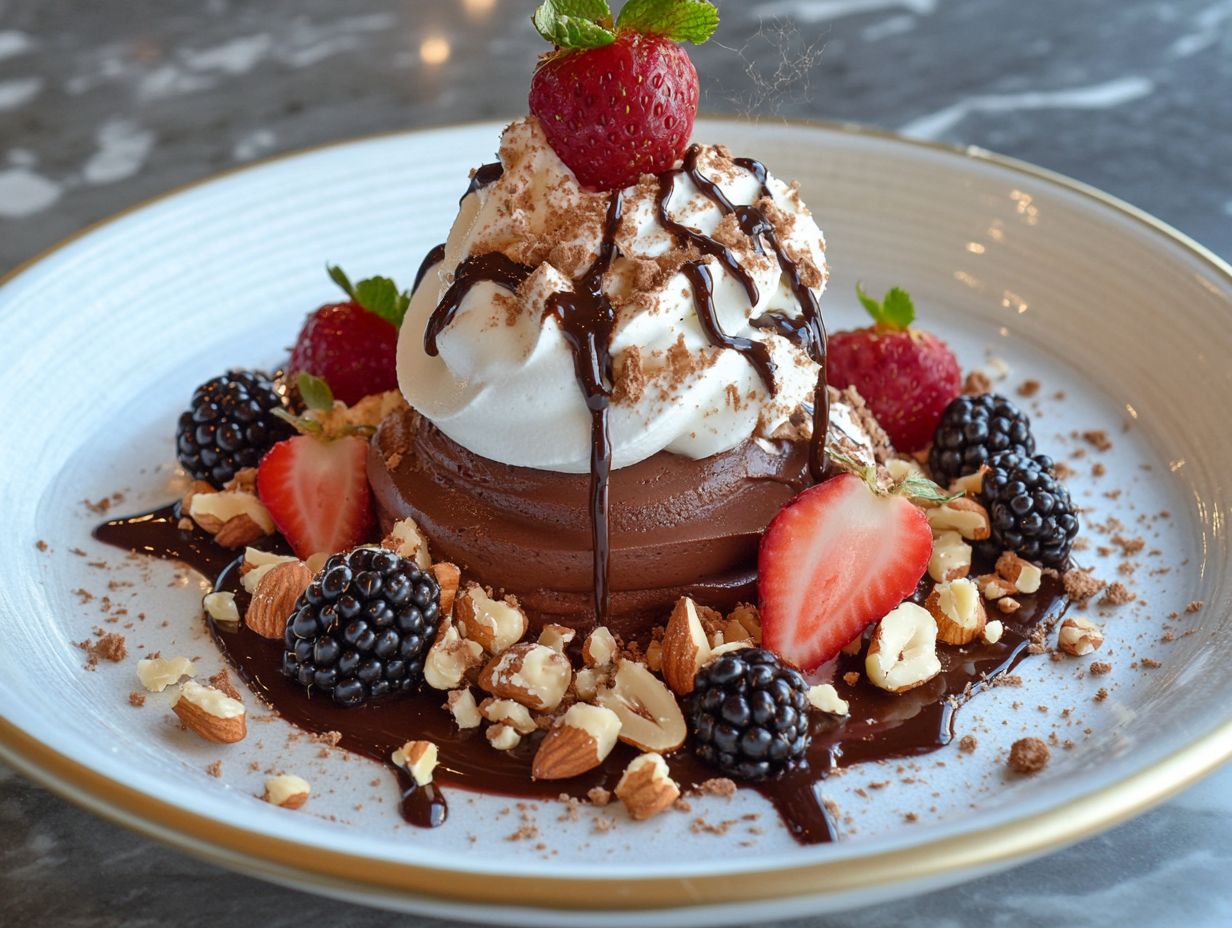
Imagine indulging in a creamy cheesecake that offers a rich and smooth mouthfeel, elevating your dessert experience to new heights. The importance of texture in dessert creation becomes abundantly clear. With their velvety consistency and the option to adorn them with fresh fruit toppings or delectable sauces, these cheesecakes create a harmonious balance of flavors and textures that tantalize your taste buds.
Using texture techniques like layering textures and adding crispy toppings can further elevate the experience. The lusciousness of the cheesecake base can be beautifully complemented by a variety of flavors, from decadent chocolate to zesty lemon or a tangy raspberry swirl. Each adds its own delightful textural experience.
Picture the satisfying crunch of a crumbly graham cracker crust, perfectly juxtaposed against the creaminess, while toppings like whipped cream or a drizzle of caramel introduce an additional layer of silky smoothness. Even the inclusion of elements such as nuts or toasted coconut can add subtle variations, enhancing both texture and overall flavor. When crafted with meticulous attention to these elements, a cheesecake transforms into a truly multi-dimensional dessert, delighting not just your palate but also your senses.
4. Chewy Brownies
Chewy brownies are a cherished dessert that offers a remarkable texture, striking an exquisite balance between fudgy and chewy, making them simply irresistible. This delightful texture not only enhances the overall flavor of the brownies but also elevates them to a must-have addition to any dessert spread. A well-crafted brownie showcases intricate texture characteristics that delight with every bite.
The chewy consistency creates a gratifying mouthfeel, inviting you to indulge as each bite lingers on your palate. To achieve this sought-after texture, it s essential to mix the brownie batter just enough to blend all the ingredients without overmixing, as doing so can result in a denser outcome.
Choosing brown sugar over granulated sugar can also contribute to a richer flavor and a chewier texture. In terms of flavor pairings, consider sprinkling sea salt flakes on top to amplify the chocolate’s richness or swirling in caramel for a delightful contrast.
Other popular toppings include toasted nuts or a sprinkle of flaky sea salt, harmonizing beautifully with the chocolate and providing a flavor experience that is both sophisticated and comforting.
What Are Some Tips for Incorporating Textures in Desserts?
Incorporating textures into your desserts demands thoughtful consideration and a touch of experimentation to achieve a delightful balance, ensuring that each element enhances the overall culinary experience. This process often involves texture analysis and the use of sensory methods to fine-tune the texture properties of your creations.
By focusing on this interplay of textures, you can craft desserts that truly tantalize the senses and engage diners in extraordinary ways, whether it s through a harmonious blend of creamy and crunchy or by playing with temperature to elevate the mouthfeel.
1. Balance the Textures
Balancing textures in your desserts is essential for enhancing the overall enjoyment of food. When you create contrasting textures, you elevate the sensory experience to something truly engaging. Take, for example, a smooth panna cotta paired with a crispy garnish. This combination not only pleases the eye but also enriches the taste through the delightful interplay of textures.
Using tools to analyze texture can help you find the right balance, ensuring each bite is a sensory delight. Consider how a rich chocolate mousse can be beautifully complemented by a light, airy meringue, generating a delightful contrast that tantalizes the palate. Similarly, the fluffy whipped cream layered with dense cake in a trifle exemplifies how varied textures evoke a sense of indulgence and satisfaction.
By incorporating elements like crunchy nuts or toasty coconut flakes into your creamy desserts, you add layers of complexity that turn each bite into a new adventure. Exploring these texture contrasts not only delights your diners but also elevates the entire dessert experience, stimulating their taste buds and fostering a deeper appreciation for the artistry of culinary creations.
Using freeze-dried ingredients or fruit preparation methods can further enhance the food enjoyment and overall presentation.
2. Experiment with Combinations
Experimenting with various combinations of textures is essential for you to craft innovative desserts that truly surprise and delight the palate. By blending creamy, crunchy, and chewy elements, you can create unique culinary experiences that elevate the enjoyment of your desserts. Get creative with dessert plating techniques to wow your guests!
For instance, consider the exquisite pairing of a silky chocolate mousse with a crisp almond brittle and a chewy caramel center. This delightful trio not only tantalizes the taste buds but also offers a visually captivating treat that draws the eye. Incorporating sensory evaluation techniques can help you fine-tune these combinations for maximum impact.
Alternatively, think about incorporating a refreshing citrus sorbet between layers of velvety mascarpone. This combination introduces a surprising burst of flavor and a delightful contrast in mouthfeel, making each bite an extraordinary experience. The world of texture offers endless possibilities for you to explore, especially when considering texture perception and the use of food properties.
Encourage your creativity by experimenting with ingredients like toasted coconut, tart berries, or even flavored jellies. Each dessert can become an exciting adventure in taste and sensation, inviting your diners to savor every moment. Consider incorporating fresh ingredients like melon garnish or edible flowers to enhance the visual appeal and flavor profile.
3. Consider Temperature
Considering temperature is essential in your dessert creations, as it can profoundly influence the mouthfeel and overall tasting experience. For instance, serving a frozen dessert at the right temperature is key to achieving optimal texture, whether you’re dishing out smooth ice cream or a refreshing sorbet that tantalizes the senses. Understanding the texture properties of different ingredients can help achieve the desired consistency.
Achieving the perfect balance often requires you to know the ideal serving temperatures for various dessert types. Take chocolate ganache, for example; allowing it to set at a cooler room temperature preserves its velvety consistency. Meanwhile, custards demand careful baking and cooling to ensure they develop that creamy, luscious feel without curdling.
Incorporating emulsifiers and stabilizers which help blend ingredients smoothly and keep your desserts from falling apart can also aid in maintaining the desired texture. In terms of baked goods like cakes, cooling them completely before icing is crucial. This prevents melting and helps you achieve that desired frosting finish.
By mastering these temperature control techniques, you can elevate your dessert game and guarantee a luxurious experience for everyone lucky enough to indulge. Consider using seasonal flavors and finishing with crispy garnishes to enhance the overall appeal.
Try these tips in your next dessert creation and impress your guests with delightful textures and flavors!
4. Think Outside the Box
Thinking outside the box is essential for you to create unique dessert experiences that defy traditional boundaries and delight diners. By incorporating unexpected elements like using savory ingredients in sweet desserts or employing innovative texture techniques you can enhance flavor perception and craft unforgettable culinary moments. Sensory evaluation and texture analysis can guide you in achieving the perfect balance of flavors and textures.
Picture this: a rich chocolate cake infused with hints of sea salt and rosemary, delivering an aromatic twist that captivates the palate. Or imagine indulging in a creamy strawberry panna cotta made with infused basil and balsamic vinegar, offering a refreshing contrast to the sweetness of conventional desserts. These culinary creations can become signature dishes that highlight your unique approach to dessert plating.
Incorporating textures like crispy caramel shards or velvety mousse elevates your dish. It also engages the senses in a new way. Dare to experiment with bold flavor profiles and create unforgettable desserts!
By embracing unconventional combinations, you can create desserts that transcend mere sweet endings and transform into culinary masterpieces that tell a captivating story. Techniques like layering textures and using food textures effectively can bring your desserts to the next level.
Frequently Asked Questions
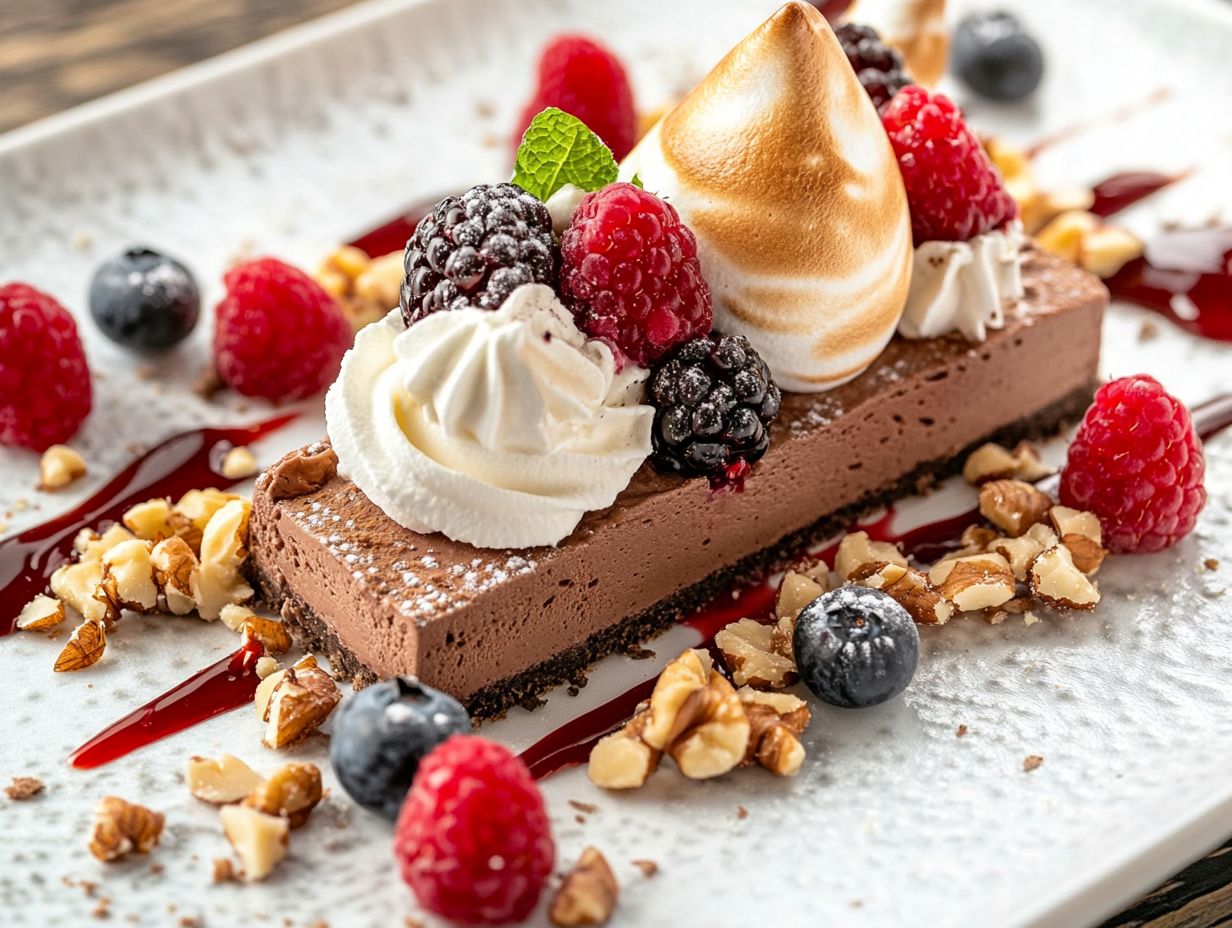
What does incorporating textures in desserts mean?
Incorporating textures in desserts means adding elements or components that create a contrast in the overall texture of the dish. This can be done through ingredients, such as adding crunchy nuts to a creamy cake, or through techniques, such as layering smooth and crispy textures in a parfait. Changing the texture of food can significantly enhance food enjoyment and contribute to a memorable dining experience.
How can I add crunchy textures to my desserts?
There are several ways to add crunch to your desserts. You can top your desserts with chopped nuts, granola, or crushed cookies. You can also mix in ingredients like cereal, puffed rice, or toasted coconut to add a crispy texture. Using freeze-dried ingredients can introduce unique crispy elements that surprise and delight.
What are some soft textures that work well in desserts?
Soft textures can add a pleasant creaminess to desserts. Some ingredients that can create a soft texture include whipped cream, mousse, custard, and pudding. You can also incorporate soft fruits, such as bananas or avocados, into your desserts for a smooth and creamy texture. Ingredients like Greek yogurt also contribute to creamy desserts with a rich mouthfeel.
How can I use fruits to add texture to my desserts?
Fruits can add both flavor and texture to desserts. You can use fruits in their natural form, such as adding sliced strawberries to a cake or using mashed bananas in a bread recipe. You can also puree fruits and use them as a sauce or incorporate them into a whipped cream topping. Fruit preparation techniques like macerating or grilling can further enhance the texture and flavor.
Ready to elevate your dessert game? Try these techniques and share your delicious creations with us!
Can different cooking techniques help create textures in desserts?
Absolutely! Different cooking techniques can add exciting textures to your desserts. For instance, baking gives a crispy exterior with a soft interior, while grilling imparts a smoky, caramelized finish. You can also try poaching, freezing, and frying to introduce unique textures. Understanding your ingredients’ texture characteristics helps you choose the right cooking methods.
Are there any tips for balancing textures in desserts?
Aim for an exciting mix! Combine at least three different textures in your dessert, such as smooth, crunchy, and chewy. Don t forget to consider the overall flavor profile to ensure the textures work well together.
Using taste testing and simple measurement techniques can help you achieve the perfect balance and enhance mouthfeel.

